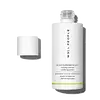What's inside
What's inside
 Key Ingredients
Key Ingredients

 Benefits
Benefits

 Concerns
Concerns

 Ingredients Side-by-side
Ingredients Side-by-side

Sodium Cocoyl Isethionate
CleansingSodium Lauroyl Glutamate
Kaolin
AbrasiveBetaine
HumectantCorn Starch Modified
AbsorbentPerlite
AbsorbentHydroxypropyl Methylcellulose
Emulsion StabilisingPotassium Olivate
EmulsifyingCharcoal Powder
AbrasivePhenethyl Alcohol
MaskingZingiber Officinale Root Oil
MaskingLactic Acid
BufferingCaprylyl Glycol
EmollientMentha Arvensis Leaf Oil
MaskingEthylhexylglycerin
Skin ConditioningCamellia Sinensis Leaf Powder
ExfoliatingAvena Sativa Kernel Flour
AbrasiveSodium Chloride
MaskingSalix Alba Bark Extract
AstringentAloe Barbadensis Leaf Juice
Skin ConditioningMaltodextrin
AbsorbentPotassium Sorbate
PreservativeSodium Benzoate
MaskingSodium Cocoyl Isethionate, Sodium Lauroyl Glutamate, Kaolin, Betaine, Corn Starch Modified, Perlite, Hydroxypropyl Methylcellulose, Potassium Olivate, Charcoal Powder, Phenethyl Alcohol, Zingiber Officinale Root Oil, Lactic Acid, Caprylyl Glycol, Mentha Arvensis Leaf Oil, Ethylhexylglycerin, Camellia Sinensis Leaf Powder, Avena Sativa Kernel Flour, Sodium Chloride, Salix Alba Bark Extract, Aloe Barbadensis Leaf Juice, Maltodextrin, Potassium Sorbate, Sodium Benzoate
Water
Skin ConditioningAloe Barbadensis Leaf Juice
Skin ConditioningGlycolic Acid
BufferingLactic Acid
BufferingGluconolactone
Skin ConditioningSalicylic Acid
MaskingNiacinamide
SmoothingBetaine
HumectantHibiscus Sabdariffa Flower Extract
Skin ConditioningTerminalia Ferdinandiana Fruit Extract
AntioxidantSodium Hyaluronate
HumectantCaprylic/Capric Triglyceride
MaskingCitrus Aurantium Dulcis Peel Extract
Emulsion StabilisingVanilla Planifolia Fruit Extract
Skin ConditioningCitrus Tangerina Peel Extract
AstringentDimethyl Isosorbide
SolventEvodia Rutaecarpa Fruit Extract
Skin ConditioningPropanediol
SolventSorbitan Oleate Decylglucoside Crosspolymer
CleansingSodium PCA
HumectantSodium Hydroxide
BufferingSodium Benzoate
MaskingWater, Aloe Barbadensis Leaf Juice, Glycolic Acid, Lactic Acid, Gluconolactone, Salicylic Acid, Niacinamide, Betaine, Hibiscus Sabdariffa Flower Extract, Terminalia Ferdinandiana Fruit Extract, Sodium Hyaluronate, Caprylic/Capric Triglyceride, Citrus Aurantium Dulcis Peel Extract, Vanilla Planifolia Fruit Extract, Citrus Tangerina Peel Extract, Dimethyl Isosorbide, Evodia Rutaecarpa Fruit Extract, Propanediol, Sorbitan Oleate Decylglucoside Crosspolymer, Sodium PCA, Sodium Hydroxide, Sodium Benzoate
Ingredients Explained
These ingredients are found in both products.
Ingredients higher up in an ingredient list are typically present in a larger amount.
Aloe Barbadensis Leaf Juice comes from leaves of the aloe plant. Aloe Barbadensis Leaf Juice is best known for helping to soothe sunburns. It is also anti-inflammatory, moisturizing, antiseptic, and can help heal wounds.
Aloe is packed with good stuff including Vitamins A, C, and E. These vitamins are antioxidants, which help fight free-radicals and the damage they may cause. Free-radicals are molecules that may damage your skin cells, such as pollution.
Aloe Barbadensis Leaf Juice also contains sugars. These sugars come in the form of monosaccharides and polysaccharides, folic acid, and choline. These sugars are able to help bind moisture to skin.
It also contains minerals such as calcium, 12 anthraquinones, fatty acids, amino acids, and Vitamin B12.
Learn more about Aloe Barbadensis Leaf JuiceBetaine is a common humectant (a substance that promotes retention of moisture). It's known to be gentle on the skin and can help balance hydration.
This ingredient is best for improving hydration and soothing irritated skin. Studies also show it helps even out skin tone.
Fun fact: Betaine is naturally created in the skin and body. The kind found within cosmetic products can be either plant-derived or synthetic.
Another name for betaine is trimethylglycine.
Learn more about BetaineLactic Acid is another well-loved alpha hydroxy acid (AHA). It is gentler than glycolic acid but still highly effective.
Its main role is to exfoliate the surface of the skin by loosening the “glue” that holds dead skin cells together. Shedding those old cells leads to smoother, softer, and more even-toned skin.
Because lactic acid molecules are larger than glycolic acid, they don’t penetrate as deeply. This means they’re less likely to sting or irritate, making it a great choice for beginners or those with sensitive skin.
Like glycolic acid, it can:
Lactic acid also acts as a humectant (like hyaluronic acid). It can draw water into the skin to improve hydration and also plays a role in the skin's natural moisturizing factor (NMF) in the form of sodium lactate.
Studies show it can boost ceramide production to strengthen the skin barrier and even help balance the skin’s microbiome.
To get results, choose products with a pH between 3-4.
Lower strengths (5-12%) focus on surface exfoliation; higher strengths (12% and up) can reach deeper in the dermis (deeper, supportive layer) to improve skin texture and firmness over time.
Though it was originally derived from milk, most modern lactic acid used in skincare is vegan. It is made through non-dairy fermentation to create a bio-identical and stable form suitable for all formulations.
When lactic acid shows up near the end of an ingredient list, it usually means the brand added just a tiny amount to adjust the product’s pH.
Legend has it that Cleopatra used to bathe in sour milk to help reduce wrinkles.
Lactic acid is truly a gentle multitasker: it exfoliates, hydrates, strengthens, and brightens. It's a great ingredient for giving your skin a smooth, glowing, and healthy look without the harshness of stronger acids.
Read more about some other popular AHA's here:
Learn more about Lactic AcidSodium Benzoate is a preservative. It's used in both cosmetic and food products to inhibit the growth of mold and bacteria. It is typically produced synthetically.
Both the US FDA and EU Health Committee have approved the use of sodium benzoate. In the US, levels of 0.1% (of the total product) are allowed.
Sodium benzoate works as a preservative by inhibiting the growth of bacteria inside of cells. It prevents the cell from fermenting a type of sugar using an enzyme called phosphofructokinase.
It is the salt of benzoic acid. Foods containing sodium benzoate include soda, salad dressings, condiments, fruit juices, wines, and snack foods.
Studies for using ascorbic acid and sodium benzoate in cosmetics are lacking, especially in skincare routines with multiple steps.
We always recommend speaking with a professional, such as a dermatologist, if you have any concerns.
Learn more about Sodium Benzoate